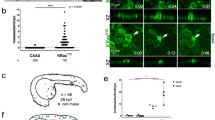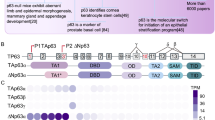Abstract
Inturned (INTU), a cilia and planar polarity effector, performs prominent ciliogenic functions during morphogenesis, such as in the skin. INTU is expressed in adult tissues but its role in tissue maintenance is unknown. Here, we report that the expression of the INTU gene is aberrantly elevated in human basal cell carcinoma (BCC), coinciding with increased primary cilia formation and activated hedgehog (Hh) signaling. Disrupting Intu in an oncogenic mutant Smo (SmoM2)-driven BCC mouse model prevented the formation of BCC through suppressing primary cilia formation and Hh signaling, suggesting that Intu performs a permissive role during BCC formation. INTU is essential for intraflagellar transport A complex assembly during ciliogenesis. To further determine whether Intu is directly involved in the activation of Hh signaling downstream of ciliogenesis, we examined the Hh signaling pathway in mouse embryonic fibroblasts, which readily responds to the Hh pathway activation. Depleting Intu blocked Smo agonist-induced Hh pathway activation, whereas the expression of Gli2ΔN, a constitutively active Gli2, restored Hh pathway activation in Intu-deficient cells, suggesting that INTU functions upstream of Gli2 activation. In contrast, overexpressing Intu did not promote ciliogenesis or Hh signaling. Taken together, data obtained from this study suggest that INTU is indispensable during BCC tumorigenesis and that its aberrant upregulation is likely a prerequisite for primary cilia formation during Hh-dependent tumorigenesis.
This is a preview of subscription content, access via your institution
Access options
Subscribe to this journal
Receive 50 print issues and online access
$259.00 per year
only $5.18 per issue
Buy this article
- Purchase on Springer Link
- Instant access to full article PDF
Prices may be subject to local taxes which are calculated during checkout





Similar content being viewed by others
References
Park WJ, Liu J, Sharp EJ, Adler PN . The Drosophila tissue polarity gene inturned acts cell autonomously and encodes a novel protein. Development 1996; 122: 961–969.
Park TJ, Haigo SL, Wallingford JB . Ciliogenesis defects in embryos lacking inturned or fuzzy function are associated with failure of planar cell polarity and Hedgehog signaling. Nat Genet 2006; 38: 303–311.
Chang R, Petersen JR, Niswander LA, Liu A . A hypomorphic allele reveals an important role of inturned in mouse skeletal development. Dev Dyn 2015; 244: 736–747.
Heydeck W, Liu A . PCP effector proteins inturned and fuzzy play nonredundant roles in the patterning but not convergent extension of mammalian neural tube. Dev Dyn 2011; 240: 1938–1948.
Zeng H, Hoover AN, Liu A . PCP effector gene Inturned is an important regulator of cilia formation and embryonic development in mammals. Dev Biol 2010; 339: 418–428.
Dai D, Li L, Huebner A, Zeng H, Guevara E, Claypool DJ et al. Planar cell polarity effector gene Intu regulates cell fate-specific differentiation of keratinocytes through the primary cilia. Cell Death Differ 2013; 20: 130–138.
Toriyama M, Lee C, Taylor SP, Duran I, Cohn DH, Bruel AL et al. The ciliopathy-associated CPLANE proteins direct basal body recruitment of intraflagellar transport machinery. Nat Genet 2016; 48: 648–656.
Gailani MR, Stahle-Backdahl M, Leffell DJ, Glynn M, Zaphiropoulos PG, Pressman C et al. The role of the human homologue of Drosophila patched in sporadic basal cell carcinomas. Nat Genet 1996; 14: 78–81.
Hahn H, Wicking C, Zaphiropoulous PG, Gailani MR, Shanley S, Chidambaram A et al. Mutations of the human homolog of Drosophila patched in the nevoid basal cell carcinoma syndrome. Cell 1996; 85: 841–851.
Xie J, Murone M, Luoh SM, Ryan A, Gu Q, Zhang C et al. Activating Smoothened mutations in sporadic basal-cell carcinoma. Nature 1998; 391: 90–92.
Oro AE, Higgins KM, Hu Z, Bonifas JM, Epstein Jr EH, Scott MP . Basal cell carcinomas in mice overexpressing sonic hedgehog. Science 1997; 276: 817–821.
Goetz SC, Anderson KV . The primary cilium: a signalling centre during vertebrate development. Nat Rev Genet 2010; 11: 331–344.
Singla V, Reiter JF . The primary cilium as the cell's antenna: signaling at a sensory organelle. Science 2006; 313: 629–633.
Oh EC, Katsanis N . Cilia in vertebrate development and disease. Development 2012; 139: 443–448.
Eggenschwiler JT, Anderson KV . Cilia and developmental signaling. Annu Rev Cell Dev Biol 2007; 23: 345–373.
Han YG, Kim HJ, Dlugosz AA, Ellison DW, Gilbertson RJ, Alvarez-Buylla A . Dual and opposing roles of primary cilia in medulloblastoma development. Nat Med 2009; 15: 1062–1065.
Wong SY, Seol AD, So PL, Ermilov AN, Bichakjian CK, Epstein EH Jr et al. Primary cilia can both mediate and suppress Hedgehog pathway-dependent tumorigenesis. Nat Med 2009; 15: 1055–1061.
Youssef KK, Van Keymeulen A, Lapouge G, Beck B, Michaux C, Achouri Y et al. Identification of the cell lineage at the origin of basal cell carcinoma. Nat Cell Biol 2010; 12: 299–305.
Youssef KK, Lapouge G, Bouvree K, Rorive S, Brohee S, Appelstein O et al. Adult interfollicular tumour-initiating cells are reprogrammed into an embryonic hair follicle progenitor-like fate during basal cell carcinoma initiation. Nat Cell Biol 2012; 14: 1282–1294.
Zilber Y, Babayeva S, Seo JH, Liu JJ, Mootin S, Torban E . The PCP effector Fuzzy controls cilial assembly and signaling by recruiting Rab8 and Dishevelled to the primary cilium. Mol Biol Cell 2013; 24: 555–565.
Zhang Z, Wlodarczyk BJ, Niederreither K, Venugopalan S, Florez S, Finnell RH et al. Fuz regulates craniofacial development through tissue specific responses to signaling factors. PLoS One 2011; 6: e24608.
Gray RS, Abitua PB, Wlodarczyk BJ, Szabo-Rogers HL, Blanchard O, Lee I et al. The planar cell polarity effector Fuz is essential for targeted membrane trafficking, ciliogenesis and mouse embryonic development. Nat Cell Biol 2009; 11: 1225–1232.
Dai D, Zhu H, Wlodarczyk B, Zhang L, Li L, Li AG et al. Fuz controls the morphogenesis and differentiation of hair follicles through the formation of primary cilia. J Invest Dermatol 2011; 131: 302–310.
Cui C, Chatterjee B, Lozito TP, Zhang Z, Francis RJ, Yagi H et al. Wdpcp, a PCP protein required for ciliogenesis, regulates directional cell migration and cell polarity by direct modulation of the actin cytoskeleton. PLoS Biol 2013; 11: e1001720.
Heydeck W, Zeng H, Liu A . Planar cell polarity effector gene Fuzzy regulates cilia formation and Hedgehog signal transduction in mouse. Dev Dyn 2009; 238: 3035–3042.
Aszterbaum M, Beech J, Epstein EH Jr . Ultraviolet radiation mutagenesis of hedgehog pathway genes in basal cell carcinomas. J Investig Dermatol Symp Proc 1999; 4: 41–45.
Villumsen BH, Danielsen JR, Povlsen L, Sylvestersen KB, Merdes A, Beli P et al. A new cellular stress response that triggers centriolar satellite reorganization and ciliogenesis. EMBO J 2013; 32: 3029–3040.
DeRouen MC, Zhen H, Tan SH, Williams S, Marinkovich MP, Oro AE . Laminin-511 and integrin beta-1 in hair follicle development and basal cell carcinoma formation. BMC Dev Biol 2010; 10: 112.
Wang GY, Wang J, Mancianti ML, Epstein EH Jr . Basal cell carcinomas arise from hair follicle stem cells in Ptch1(+/-) mice. Cancer Cell 2011; 19: 114–124.
Grachtchouk M, Pero J, Yang SH, Ermilov AN, Michael LE, Wang A et al. Basal cell carcinomas in mice arise from hair follicle stem cells and multiple epithelial progenitor populations. J Clin Invest 2011; 121: 1768–1781.
Peterson SC, Eberl M, Vagnozzi AN, Belkadi A, Veniaminova NA, Verhaegen ME et al. Basal cell carcinoma preferentially arises from stem cells within hair follicle and mechanosensory niches. Cell Stem Cell 2015; 16: 400–412.
Sanchez-Danes A, Hannezo E, Larsimont JC, Liagre M, Youssef KK, Simons BD et al. Defining the clonal dynamics leading to mouse skin tumour initiation. Nature 2016; 536: 298–303.
Von Hoff DD, LoRusso PM, Rudin CM, Reddy JC, Yauch RL, Tibes R et al. Inhibition of the hedgehog pathway in advanced basal-cell carcinoma. N Eng J Med 2009; 361: 1164–1172.
Atwood SX, Sarin KY, Whitson RJ, Li JR, Kim G, Rezaee M et al. Smoothened variants explain the majority of drug resistance in basal cell carcinoma. Cancer Cell 2015; 27: 342–353.
Metcalfe C, de Sauvage FJ . Hedgehog fights back: mechanisms of acquired resistance against Smoothened antagonists. Cancer Res 2011; 71: 5057–5061.
Pricl S, Cortelazzi B, Dal Col V, Marson D, Laurini E, Fermeglia M et al. Smoothened (SMO) receptor mutations dictate resistance to vismodegib in basal cell carcinoma. Mol Oncol 2015; 9: 389–397.
Basset-Seguin N, Sharpe HJ, de Sauvage FJ . Efficacy of Hedgehog pathway inhibitors in basal cell carcinoma. Mol Cancer Ther 2015; 14: 633–641.
Atwood SX, Chang AL, Oro AE . Hedgehog pathway inhibition and the race against tumor evolution. J Cell Biol 2012; 199: 193–197.
Wong SY, Dlugosz AA . Basal cell carcinoma, Hedgehog signaling, and targeted therapeutics: the long and winding road. J Invest Dermatol 2014; 134: E18–E22.
Kim J, Tang JY, Gong R, Kim J, Lee JJ, Clemons KV et al. Itraconazole, a commonly used antifungal that inhibits Hedgehog pathway activity and cancer growth. Cancer Cell 2010; 17: 388–399.
Infante P, Alfonsi R, Botta B, Mori M, Di Marcotullio L, Targeting GLI . factors to inhibit the Hedgehog pathway. Trends Pharmacol Sci 2015; 36: 547–558.
Kim DJ, Kim J, Spaunhurst K, Montoya J, Khodosh R, Chandra K et al. Open-label, exploratory phase II trial of oral itraconazole for the treatment of basal cell carcinoma. J Clin Oncol 2014; 32: 745–751.
Yasuda M, Claypool DJ, Guevara E, Roop DR, Chen J . Genetic manipulation of keratinocyte stem cells with lentiviral vectors. Methods Mol Biol 2013; 989: 143–151.
Zeng H, Jia J, Liu A . Coordinated translocation of mammalian Gli proteins and suppressor of fused to the primary cilium. PLoS One. 2010; 5: e15900.
Yuspa SH, Kilkenny AE, Steinert PM, Roop DR . Expression of murine epidermal differentiation markers is tightly regulated by restricted extracellular calcium concentrations in vitro. J Cell Biol 1989; 109: 1207–1217.
Acknowledgements
We thank Stephanie Burke and Mallory Korman for histology assistance. This study is supported by the Research Histology Core Laboratory of the Department of Pathology, the Cancer Center of Stony Brook University, and research grants from NIH (AR061485 to JC; AR060388 and CA052607 to DRR), a Young Investigator Career Development Award from the PKD foundation (02YI08A to AL), a Pilot and Feasibility Award from the SDRC of University of Colorado Denver (NIH, AR057212), and the REACH program of Stony Brook University (NIH, U01HL127522 and the NYS Department of Economic Development, C140151).
Author information
Authors and Affiliations
Corresponding author
Ethics declarations
Competing interests
The authors declare no conflict of interest.
Additional information
Supplementary Information accompanies this paper on the Oncogene website
Supplementary information
Rights and permissions
About this article
Cite this article
Yang, N., Leung, EH., Liu, C. et al. INTU is essential for oncogenic Hh signaling through regulating primary cilia formation in basal cell carcinoma. Oncogene 36, 4997–5005 (2017). https://doi.org/10.1038/onc.2017.117
Received:
Revised:
Accepted:
Published:
Issue Date:
DOI: https://doi.org/10.1038/onc.2017.117
This article is cited by
-
Clinical Implications of Primary Cilia in Skin Cancer
Dermatology and Therapy (2020)
-
Freeing the brake: Proliferation needs primary cilium to disassemble
Journal of Biosciences (2020)
-
Ciliary signalling in cancer
Nature Reviews Cancer (2018)
-
The primary cilium – once a “rudimentary” organelle that is now a ubiquitous sensory cellular structure involved in many pathological disorders
Journal of Cell Communication and Signaling (2018)



